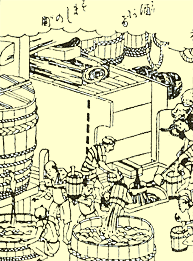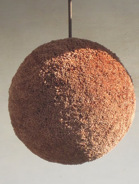|
|
Greetings in the supposedly-approaching spring,
And what a tumultuous winter it has been! Record-breaking snowfall -
meters upon meters have fallen in Niigata and other northern prefectures. It is the coldest winter here I recall in two decades! My bones have not thawed since October. (Central heating would help, but let’s not go there…) My other great passion in Japan - the ancient sport-culture of Sumo, is on the verge of collapse, or at least the organization that runs it is. And the Yamada Nishiki rice is the pits this year.
But it’s all about to get better! The winter is about over. Sumo will work it out and re-invent itself. And every brewer I have spoken to has asserted that, yes, the rice this year sucks, but they have been able to tweak their processes to ensure things are fine. Hope springs eternal. Again.
This month’s newsletter looks at the idiosyncratic system of toji (master brewers), how and why it came into being, and why it is changing and fast. There are also a handful of announcements, including the Sake Professional Course NYC this summer, the launching of the Sake Education Council website, and the new, improved, audio-enhanced iPhone app The Sake Dictionary, and its new low price. Finally, the Sake Education Council website has launched. Check it out and learn more about us and what we are doing. While it may be longish this month, please enjoy reading it.
Warm regards in the gradual thaw,
John
 
|

The Brewers that Could Not BrewHow the Toji System is Changing
Yasutaka Daimon, seventh generation owner - and now toji - of
the company brewing Rikyubai and Mukune, knelt regally before the 20 of us in his 150-year old home. He was addressing the participants of the Sake Professional Course, visiting his kura on the final night of the weeklong course. In due course, he began to explain how he came to take over the reigns of master brewer a scant three years ago, after seven generations of leaving that to outsiders.
“Long ago,” he began, “when starting a sake-brewing business, the first and most important thing we needed was a license to brew from the government.” Even going back several hundred years, the then-feudal government of Japan controlled sake brewing and gathered taxes through licensing. One might be wealthy and have expansive fields of rice, but without that piece of paper from the shogunate, not a drop of sake could be legally brewed.
“Next, of course, we had to have money. Rice is paid for up front, as is everything else. So money is needed to get started. Then came the raw materials - rice, and lots of good water. The former of course we could buy, the latter we could find by digging wells.” Japan is a land rich in good water. Just dig a hole about anywhere and up it comes. Of course, water that is primo for sake brewing is a bit harder to come by; but a bit of poking around almost always led to a source of good water for brewing sake. So far, everything needed could be procured on their own.
“After all of this, came the technology - the actual ability to brew the sake; the skills and experience to create something good enough to sell. And this is where we were lacking; this is what we could not source by ourselves.
“So what we had to do was to hire outside experts, brewing journeymen to come in and create our sake for us. We had the license, the money, the rice and the water. But we did not have the know-how."
And so what sakagura for centuries have done is to hire toji (brewmasters) and kurabito (brewing personnel under the toji) from elsewhere, usually farmers from nearby farmlands, to come into the brewery on a seasonally contracted basis and handle the actual brewing for them.
“This is different from any other industry, even amongst traditional
industries in Japan. The family and company creating a product has everything - except the knowledge to actually make the product. And that,” he concluded, “has come back to haunt us."
It is this awareness that incentivized Mr. Daimon to follow a seeming trend amongst the 1300-odd breweries in the industry and bring the skills to brew his product back home into the family, or at least the company. And that led to him taking over the reigns as toji a few years ago.
In fact, today, some estimates say that a full one-third of the industry now employs toji that are not from the traditional guilds, but either part of the family or local or full time (rather than seasonal) employees.
Now, even though I referred to this as a trend, in truth, only small-ish brewers can pull this off. A company of even moderate size would have the owner busy conducting business, strategizing, dealing with finances, and hiring and firing. But having thrown that caveat in to the mix it is just as important to point out that probably more than half the industry is of a small enough scale where being owner-toji is possible.
While, from the vantage point of those brewers, this is a good thing, empowering to the industry and enabling diversity amongst the brewers, not everyone is equally served. One traditional-guild-associated toji at another brewery recently lamented that a friend of his, a toji himself, was finding it very hard to find a job. Certainly the overall contraction of the industry is contributing to this, but surely the trend for smaller brewers to “bring it all back home” rather than hire from the traditional guilds is affecting it as well.
On a slight tangent, at the end of last year, the “National Association of Toji Guilds” (not their official English name, I am sure, but easier to understand then Nihonshuzou Toji Kumiai Rengokai) began a testing and certification program for toji. A total of 193 passed the first exam to become licensed toji, in an effort to fight the aging and lack-of-successor problems. This is the first national standardized test and represents a new level of cooperation amongst the remaining guilds, 17 of which are part of this association.
Those that passed had from five years experience to 54 years experience, and ranged in age from 31 to a spritely 86, and included three women. Let us wish them all - as well as the home-grown toji of the industry - improved security and success.
|
 Did You Know? Did You Know?

The best sake is brewed in the coldest
months of the year. Why? Two main reasons. One, the lower ambient temperatures
allow brewers to control the temperature of the fermenting mash more easily.
The lower that is, the slower fermentation proceeds, and the more clean and
(often) aromatic the sake becomes. Two, lower temperatures mean a more
difficult environment for nasty bacteria to thrive in, and creating a proper
environment that supports the process is the main objective of sake brewers.So, at
most kura, the best batches were begun just about a month ago, and right now is
the time they are being pressed - meaning the completed sake is separated from
the lees. One of several methods can be used, but just about now is the time
when the best sake of the year is born. |
 Sake Basics Sake Basics
How should you be storing your sake at
home? Well, first of all, don’t store it forever! Sake is - in general - meant
to be consumed fairly young. This does not mean that there are no sake that
stand up to maturity, or that there are no aged sake. There are both! But in
general, drink ‘em young, as the brewer intended you to do.
Next, the short answer to the above
question is to treat sake like a wine: keep it cool and in the dark. You’ll be
good for months, should you need to wait that long. Higher temperatures speed
up maturation, so the cooler the better.
Does that mean refrigeration? No, not
necessarily. Sake is fine outside the fridge, as long as too much time does not
pass. But, if you have the room there, refrigeration will slow down maturation.
However, if your sake is nama
(unpasteurized), then yes, do keep it in the refrigerator, or it the chances
that it will get nasty and undrinkable are high.
And,
the above is assuming the bottle is unopened. If it has indeed been opened, the
game changes. Sake will oxidize, although not as fast as wine. And while a lot
of sake will actually stand up to weeks or more after having been opened, the
least common denominator is more like a week or two before you see any
degradation of aromas or flavors. |
 Announcements and Events Announcements and Events
Sake Professional Course in New York City

July 31 ~ August 2, 2011
"No sake stone remains left unturned."
The next stateside running of the Sake Professional Course will be held at Astor Center in New York City on Sunday, July 31 through Tuesday, August 2, 2011. The course will run basically 9 to 5 all three days, and will conclude with certification testing for the Certified Sake Specialist, recognized by the Sake Education Council. For more information go here . Feel free to ask me any questions about the course, or make a reservation with an email to info@sake-world.com.
Sake Education Council Website is Live!
Please take a moment to check out the newly completed website for the Sake Education Council, the organization behind the Certified Sake Professional and Advanced Sake Professional certifications. We plan to grow steadily, strongly and continually, and we will need the support of all those that love sake to do so. Follow us through the "usual suspects" of social media.
|
 Sake Education Central Sake Education CentralThe Sake Dictionary App for the iPhone and iPod
Newly improved, now with audio, and drastically reduced in price to $0.99!
There you are, perusing a menu, or standing in front of a shelf of great sake, or perhaps reading a sake newsletter… and up pops one of those hairy, pesky sake terms in Japanese. You know you have heard it many times, but dammit, you just cannot remember what it means now…
No problem! Just whip out your iPhone or iPod and fire up your trusty old version of The Sake Dictionary. In a matter of seconds, you’ll be amongst the cognoscenti once again. But… if only you could pronounce it properly. Now that would really rock!
Done! Just tap on the term and you will hear a clear example of how to pronounce the term in Japanese. Repeat it a couple of times and the term is yours for eternity, to toss about and impress your mates.
What’s more, it’s less! Less than what it cost before, much less. Like less than one-seventh less. For a limited time only, the audio-enhanced version of The Sake Dictionary iPhone app is available for a mere $0.99.
The Sake Dictionary is a concise little package of all the terms you might ever come across when dealing with sake. Almost 200 of them - including sake grades, rice variety names, seasonal sake terms, special varieties, rare types, post-brewing processing words and the myriad terms used in sake production - many of which are not even familiar to the average Japanese person on the street - are listed up here with concise, useful and clear definitions and the written Japanese version as well. And now, with the new audio component, you can listen and learn just how to pronounce those terms properly.
Start to toss around Japanese sake terms like you were raised knowing them! Gain a level of familiarity hitherto unimaginable! Avoid frustrating paralysis when faced with a sake-related purchase!
Get your copy of The Sake Dictionary now and never be confused by sake terms - or how to pronounce them - again.
Get it here: http://itunes.com/apps/sakedictionary
(Note if you have already purchased it, this upgrade to the audio version is free. Just go to iTunes and get it!) |
Stay Subscribed!
Are you not getting this newsletter? I realize that is like asking that "those not present please raise your hand," but for future reference, should you spontaneously stop receiving this newsletter, please go here and sign up again. Should that not work, please go to www.sake-world.com.
Email newsletter services are very careful not to be considered spam enablers, but the problem is that often very valid email addresses come back bounced as invalid. It is an unavoidable problem. So if you or someone you know is not getting this, or stop(s) receiving it inexplicably, please do take a moment to double check that you are still subscribed.
Sincere apologies for the hassle, mixed with gratitude for reading this newsletter.
|
I hope you have found the above information helpful and entertaining. For more information about all things sake, please check out www.sake-world.com. Until next month, warm regards, and enjoy your sake. 
Questions and comments should be directed to John Gauntner, at this email address.
All material Copyright, John Gauntner & Sake World Inc.
Regards,
John Gauntner
Sake World, Inc
 . . 
|
|
